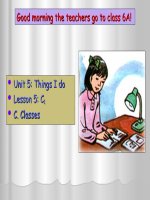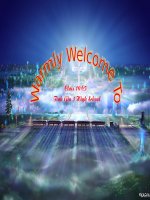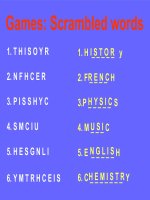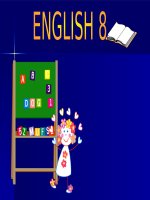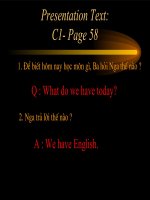Unit 5 electric motor
Bạn đang xem bản rút gọn của tài liệu. Xem và tải ngay bản đầy đủ của tài liệu tại đây (446.5 KB, 7 trang )
Unit 5: Electric Motor
Task 1
Working in your group, list as many items as you can in the home which use electric
motors. Which room has the most items?
Reading Skimming
Now you study scanning -locating specific information quickly. Another useful strategy
is reading a text quickly to gel a general idea of the kind of information it contains. You
can then decide which parts of the text are worth reading in more detail later,
depending on your reading purpose. This strategy is called skimming.
Task 2
Skim this text and identify the paragraphs which contain information on each of these
topics. The first one has been done for you.
a What electric motors are used for
paragraph 1
b The commutator
c Why the armature turns
d Electromagnets
e Effect of putting magnets together
f The armature
Para
1
In an electric motor an electric current and magnetic field produce a turning
movement. This can drive all sorts of machines, from wrist-watches to trains.
The motor shown in Fig. 1 is for a washing machine. It is a universal motor,
which can run on direct current or alternating current.
2
An electric current running through a wire produces a magnetic field around
the wire. If an electric current flows around a loop of wire with a bar of iron
through it, the iron becomes magnetized. It is called an electromagnet; one
end becomes a north pole and the other a south pole, depending on which way
the current is flowing around the loop.
3
If you put two magnets close together, like poles-for example, two north poles
- repel each other, and unlike poles attract each other.
31
4
5
6
In a simple electric motor, like the one shown in Fig. 2, a piece of iron with
loops of wire round it, called an armature, is placed between the north and
south poles of a stationary magnet, known as the field magnet. When
electricity flows around the armature wire, the iron becomes an
electromagnet.
The attraction and repulsion between the poles of this armature magnet and
the poles of the field magnet make the armature turn. As a result, its north
pole is close to the south pole of the field magnet. Then the current is reversed
so the north pole of the armature magnet becomes the south pole. Once again,
the attraction and repulsion between it and the field magnet make it turn. The
armature continues turning as long as the direction of the current, and
therefore its magnetic poles, keeps being reversed.
To reverse the direction of the current, the ends of the armature wire are
connected to different halves of a split ring called a commutator. Current
flows to and from the commutator through small carbon blocks called
brushes. As the armature turns, first one half of the commutator comes into
contact with the brush delivering the current, and then the other, so the
direction of the current keeps being reversed.
32
Task 3
Match each of these diagrams with the correct description. A, B, C, or D. One of the
descriptions does not match any of the diagrams. (The diagrams are in the correct
sequence, but the descriptions are not.)
A
The armature turns a quarter of a turn. Then electric contact is broken because of
the gap in the commutator, but the armature keeps turning because there is nothing
to stop it.
B
When current flows, the armature becomes an electromagnet. Its north pole is
attracted by the south pole and repelled by the north pole of the field magnet.
C
When a universal motor is run on direct current, the magnetic poles in the
armature change while those of the field magnet remain constant.
D
When the commutator comes back into contact with the brushes, current flows
through the armature in the opposite direction. Its poles are reversed and the turn
continues.
33
Language study Describing function
Try to answer this question:
What does an electric motor do?
When we answer a question like this, we describe the function of something. We can
describe the function of an electric motor in this way:
An electric motor converts electrical energy to mechanical energy.
We can emphasize the function like this:
The function of an electric motor is to convert electrical energy to mechanical energy.
Task 4
Match each of these motor components to its function, and then describe its function in a
sentence.
Component
Function
1. armature
a. transfer rotation from the motor
2. bearings
b. create an electromagnetic field
3. brushes
c. converts electromagnetic energy to rotation
4. commutator
d. reverses the current to the armature
5. drive shaft
e. support the drive shaft
6. field windings
f. supply current to the armature
1-c; 5-a; 2-e; 4-d; 3-f; 6-b
Task 5
Writing Describing components
Dismantle this simple dc motor into its components by completing the labeling of the
chart below.
34
Now study this description of the motor.
A simple dc motor consists of a field magnet and an armature. The armature is placed
between the poles of the magnet. The armature is made up of a loop of wire and a split
ring known as a commutator. The loop is connected to the commutator. Current is
supplied to the motor through carbon blocks called brushes.
To write a description, you need to use language to:
1 dismantle a piece of equipment into its main parts. These expressions
will help:
consists of
A A is made up of
X
X and Y
is composed of
Y
2 name components:
known as
Carbon blocks
brushes.
called
35
3 locate components:
The armature is placed between the poles.
4 connect components:
The loop is connected to the commutator.
Task 6:
Complete the text with the help of the diagram on the next page. Use the following
words:
are made up
is placed
is composed
consists
A transformer …………….of two coils, a primary and a secondary. The coils are wound
on a former which is mounted on a core. The coils…………….of a number of loops of
wire. The core…………….of thin pieces of soft iron. U- and T-shaped pieces are used.
The former…………….on the leg of the T.
Now label the diagram opposite using the completed text.
Word study
Study these expressions for describing how components are connected to each other.
A is bolted to B
=
A is connected to B with bolts.
36
A is welded to B
=
A is connected to B by welding.
A is fixed to B
=
no specific method given.
Explain each of these methods of connection.
1 screwed
2 soldered
3 attached
4 wired
5 bonded
6 glued
7 riveted
8 welded
9 brazed
10nailed
37
